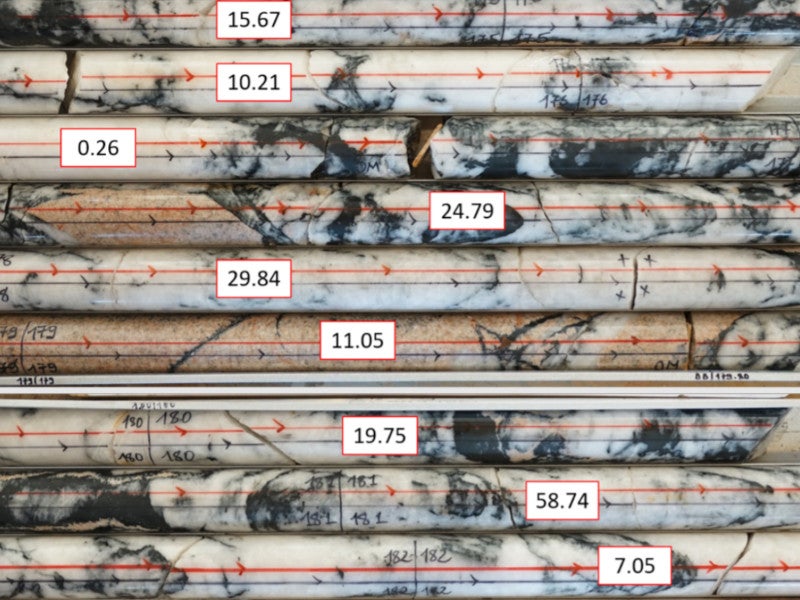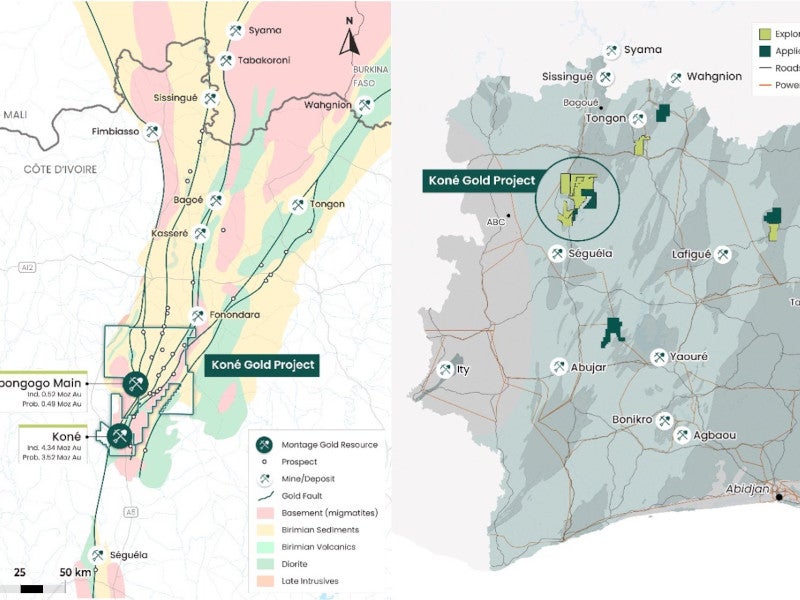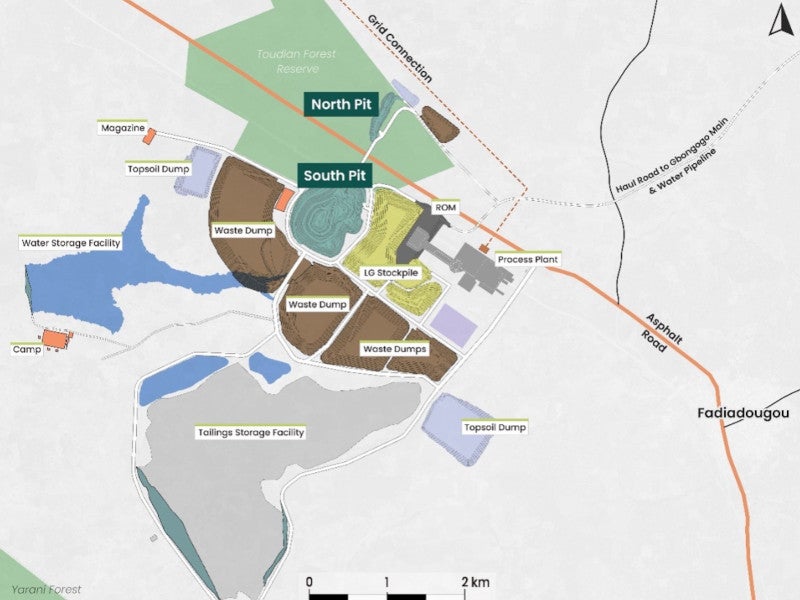The Kone gold project is an open-pit mining development in Cote d’Ivoire. It is the largest and most advanced standalone gold project in the region.
Montage Gold, a Canada-based precious metals exploration and development company, is the project’s owner and developer.
The definitive feasibility study (DFS) for the project was concluded in March 2022 while an updated feasibility study was finalised in January 2024.
The project is expected to produce an average of 223,000 ounces (oz) of gold annually over its 16-year mine life.
The permitting process is currently in progress and all necessary approvals are expected to be obtained by the third quarter of 2024. A pre-production capital investment of $712m has been allocated for developing the project.
Location of the Kone gold project
The Kone gold project is located approximately 470km north-west of Abidjan, the commercial capital of Cote d’Ivoire.
The project encompasses six exploration permits PR262, PR748, PR842, PR879b, PR919, and PR920, covering 1,801km², and two applications spanning an additional 456km².
Geology and mineralisation
The Kone gold project includes the Kone and Gbongogo gold deposits, located within the Birimian Baoule-Mossi domain of the West African Craton. The area’s geology is characterised by structurally emplaced Birimian mafic volcanic rocks and sediments, such as conglomerates and sandstones.
The gold mineralisation typically occurs within intrusive rocks amid a broad zone of shearing and foliation, associated with quartz, quartz-carbonate, and sulphide veins, as well as finely disseminated pyrite and biotite alteration. Higher gold concentrations correlate with increased deformation intensity and veinlet frequency.
The mineralisation at Kone is hosted within a 150m-330m wide quartz diorite package, dipping 45°-50° west and extending north-south. The package intrudes into folded mafic volcaniclastic country rocks.
Reserves at the Kone gold project
The probable ore reserves at the Kone gold project are estimated at 174.3mt grading 0.72g/t, containing 4.01 million ounces (moz) of gold, as of January 2024.
Mining method
The Kone gold project will employ conventional open-pit mining methods, utilising a truck and shovel fleet. Contractor-led mining operations will utilise a fleet of 90t rigid body haul trucks and appropriate loading units.
The mining strategy is to adopt a high cut-off grade in the first nine years, prioritising ore processing with a gold grade above 0.5g/t. Ore below the grade but above the economic cut-off will be stockpiled or used as supplementary feed. After the high-grade ore is exhausted, the stockpiled low-grade ore will be processed over an additional six years.
The project will develop three pits, including the northern pit (70m depth), the southern pit (495m depth), and the Gbongogo Main pit (220m depth).
The overall strip ratio for the project is 1.18:1, with individual ratios of 1:01 for Kone South, 1.19 for Kone North, and 3.77 for Gbongogo Main.
Ore processing
The plant’s design is centred on a nominal processing capacity of 11 million tonnes per annum (mtpa) of ore, with a maximum head grade of 1.29g/t of gold and a peak gold recovery rate of 91.6%.
The processing sequence will involve primary and secondary crushing, utilising a gyratory crusher and a pair of cone crushers in a closed circuit to produce a crushed product with a P80 size of approximately 31mm.
The crushed ore will pass through two parallel high-pressure grinding rolls (HPGRs) operating in a closed circuit with wet-sizing screens. The resultant undersize slurry will be directed to the milling circuit through a cyclone feed hopper, to two parallel trains of ball mills operating in closed-circuit with hydrocyclones.
A pre-leach thickener will be used to increase the density of the slurry, thereby optimising the feed for the leaching and carbon-in-pulp (CIP) circuit.
The leaching circuit will consist of 14 tanks, organised into two parallel trains of seven tanks in series, providing a total leach residence time of 36 hours. The system will be enhanced with external oxygen contactors for efficiency.
Gold will be recovered by a Kemix Pumpcell CIP circuit, which comprises eight tanks designed to minimise carbon inventory, gold in circuit, and operational costs.
Gold extraction will continue with a 20t elution circuit, which will be integrated with an electrowinning and gold smelting process to recover gold from the loaded carbon, resulting in a gold/silver doré.
Site infrastructure
The site is accessible throughout the year, through an asphalt highway situated within 300m of the proposed plant location. A 38.1km haul road from Gbongogo provides mine access.
Power will be supplied through a new 225kV transmission line from the National Grid.
Water will be obtained from the adjacent Marahoue River through dewatering of the pit and from an additional borefield. A facility for river water extraction is to be built near the Marahoue River bridge, about 26km north of the water storage facility.
Contractors involved
SRK Consulting (UK), a consulting company specialising in natural resource and development sectors, conducted the geotechnical review as part of the updated feasibility study.
Hydrogeological investigations, including groundwater modelling and pit dewatering estimates, were carried out by Australian Groundwater and Environmental Consultants (AGEC), a firm with expertise in groundwater assessment and management.
An environmental and social impact assessment was prepared by Minesia, a consultancy firm with experience in environmental and social governance in the mining industry.
General administration, processing costs, and process recovery estimates were made by Montage, with input from Lycopodium, an engineering and project management consultancy.
Mineral reserve estimate, mining parameters and associated costs were prepared by Carci Mining Consultants.






